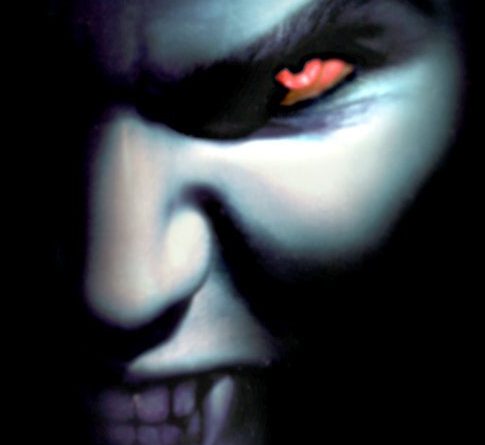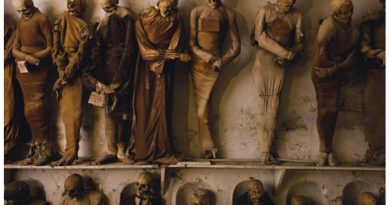Mysteries of Vampire Mythology
The idea of the vampire has caused some extreme behaviour. In October 1974 a drunkard was lured to the home of a Mr Lorca in Germany. Promising him food and shelter, instead, Mr Lorca descended on the man and bit him hard on the neck, drawing blood.
Passing out, when the drunkard came round, he rushed out of the house and went to the police. Arriving a short time later, they found Mr Lorca asleep in a coffin with blood on his lips. Mr Lorca, it seems, liked to be called Count, ate only raw meat and was only active at night.
STRANGE BEHAVIOUR
Polish immigrant to the UK, Demetrious Myicura, was found dead in 1973. His room was covered in ceremoniously placed garlic. Said to have been terrified of a vampire attack, he choked to death on a clove of garlic he had placed in his mouth to protect him while he slept.
Although tragic, we can see a degree of irony in such cases. But ideas of vampirism can affect entire societies. For instance, the Kashubs are a Christian sect of Slavs living mainly around Ontario who retain many pagan practices.
As professor of Slavic languages Jan Perkowski discovered when he visited a Kashub farm in 1968, principal is their belief in vampires. Indeed, one wife had her upper incisors removed because she was a vampire. Upon death, elaborate measures must be taken otherwise the person will rise at midnight and suck the life and blood from family members.
MYTHICAL SUCKERS
The above cases are modern survivals of a rich vampire mythology. Consider the al, the half human, half animal vampire from Armenian folklore, thought to be based on the alu of Babylonian myth.
One eyed with iron teeth, tusks and snake-like hair, it wears a triangular hat that makes it invisible. Its victim is the pregnant woman and her unborn child, whom it strangles. The best defence against the al is to surround yourself with, and use, iron implements.
The empusa is an ancient Greek vampire spirit which often appears as an alluring young woman. Its intention is to seduce young men and eventually enter them and consume their flesh and blood. Ancient magician Apollonius was said to have told one story of Menippus from Lycia.
Extremely handsome, he met a beautiful woman on a road and fell in love with her. As he decides to marry, Apollonius is suspicious and tells the man he is marrying a vampire. The magician is asked to leave, but he has broken the spell, the woman admitting her desire to kill him and consume him.
THEY GET EVERYWHERE
The mullo is a boneless, restless spirit associated with Gypsies. The word means living dead, and it comes back to strangle animals and people it didnt like in life. Invisible to all but the former spouse, it has hair that touches the ground and enjoys repossessing the spouse, often thought to make them pregnant. The spouse, however, will have his or her life sucked out by this supernatural rape. A Romanian curse is the usual way to get rid of the mullo.
Of very ancient pedigree is Ornias, a fallen angel who appeared as a man to suck the life out of boys before flying off as a heavenly winged creature. He makes his appearance in the apochryphal text, Testament of Solomon, where he hindered the building of Solomons
Temple by terrorising the boys working there.
Solomon asks God for powers to control the demon. Archangel Ariel assists Solomon in forcing Ornias to cut stone from the quarry before despatching him to Beelzebub, Prince of Demons.Even Native Americans have their vampiric folklore. Cherokee lore tells of the Iron Fingered Demon. As recorded in North Carolina in 1892, the demon can enter a household at night by impersonating an absent member. In a persons sleep, he can pierce the side with his finger and remove parts of the liver and lungs. The sleeper awakes, unaware of the attack, but begins to whither away and die.
RATIONAL IDEALS
On a rational level, many of these tales can be seen as moral or social warnings, such as being careful with strange beautiful young women, and a way of frightening young boys to keep away from strangers.
Even more interesting is the high incidence of iron in such tales. Did old medicine have an understanding of the need for iron to help cure anemia, which could give classic symptoms of a vampire attack?
Superstition was always the best way to frighten a people into sensible moral and healthy behaviour. As such, myths such as the above played a vital function in pre-scientific times. And it seems it began a culture of the supernatural of vampires – that remains to this day.
© Anthony North, March 2008
From Wikipedia :
Vampires are mythological or folkloric revenants, who subsist by feeding on the blood of the living. In folkloric tales, the undead vampires often visited loved ones and caused mischief or deaths in the neighbourhoods they inhabited when they were alive. They wore shrouds and were often described as bloated and of ruddy or dark countenance, markedly different from today’s gaunt, pale vampire which dates from the early 1800s. Although vampiric entities have been recorded in most cultures, the term vampire was not popularised until the early 18th century, after an influx of vampire superstition into Western Europe from areas where vampire legends were frequent, such as the Balkans and Eastern Europe, although local variants were also known by different names, such as vrykolakas in Greece and strigoi in Romania. This increased level of vampire superstition in Europe led to what can only be called mass hysteria and in some cases resulted in corpses actually being staked and people being accused of vampirism.
In modern times, however, the vampire is generally held to be a fictitious entity, although belief in similar vampiric creatures such as the chupacabra still persists in some cultures. Early folkloric belief in vampires has been ascribed to the ignorance of the body’s process of decomposition after death and how people in pre-industrial societies tried to rationalise this, creating the figure of the vampire to explain the mysteries of death. Porphyria was also linked with legends of vampirism in 1985 and received much media exposure, but has since been largely discredited.
The charismatic and sophisticated vampire of modern fiction was born in 1819 with the publication of The Vampyre by John Polidori; the story was highly successful and arguably the most influential vampire work of the early 19th century. However, it is Bram Stoker’s 1897 novel Dracula which is remembered as the quintessential vampire novel and provided the basis of the modern vampire legend. The success of this book spawned a distinctive vampire genre, still popular in the 21st century, with books, films, and television shows. The vampire has since become a dominant figure in the horror genre.
The Twilight Saga
Twilight is a series of four vampire-based fantasy romance novels by American author Stephenie Meyer. It charts a period in the life of Isabella “Bella” Swan, a teenage girl who moves to Forks, Washington, and falls in love with a 104-year-old vampire named Edward Cullen. The series is told primarily from Bella’s point of view, with the epilogue of Eclipse and Part II of Breaking Dawn being told from the viewpoint of character Jacob Black, a werewolf. The unpublished Midnight Sun is a retelling of the first book, Twilight, from Edward Cullen’s point of view. The novella The Short Second Life of Bree Tanner, which tells the story of a newborn vampire who appeared in Eclipse, was published on June 5, 2010 as a hardcover book and on June 7 as a free online ebook
Eclipse
The vampire Victoria (James’ mate from Twilight) has created an army of “newborn” vampires to battle the Cullen family and murder Bella for revenge. Meanwhile, Bella is compelled to choose between her relationship with Edward and her friendship with Jacob. Edward’s vampire family and Jacob’s werewolf pack join forces to successfully destroy Victoria and her vampire army. In the end, Bella chooses Edward’s love over Jacob’s and agrees to marry him.
The Twilight Saga – Eclipse
Bella Swan is reunited with the love of her life (and vampire), Edward Cullen. Her life is back to the way it was before the Cullens left, except for one major thing. Before Edward left, Bella had not considered Jacob Black (werewolf) her best friend, and she is in vain trying to make Edward and Jacob make peace and be friends. She is torn between the love she feels for Edward and the strong friendship between her and Jacob. Can she make them see reason, and can they be good to each other to keep from hurting Bella? And there are new dangers lurking around the corners; Seattle is stalked by mass murderers beyond humanity. Who’s behind this, and what connection does it have with Bella? Everyone sparkles.



